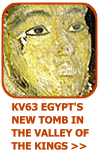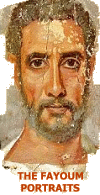|
|
||||||||||||||||||
|
|
featured temples: abu simbel | karnak
Ipet-isut - "the most sacred of places" One of the largest and most impressive of all the temple sites in Egypt, Karnak is the culmination of three main temples, several smaller enclosed temples, and a number of outer temples - the combined achievements of a great many generations of ancient builders. The vast complex was built and enlarged over a period of 1300 years and stands on a site covering 247 acres of land. Although badly ruined, probably no site in Egypt is more impressive than Karnak. It is the largest ancient temple complex ever built by man, and represents the combined achievement of many generations of early builders. Only one of the main areas is currently accessible for tourists and the general public - this is the "main" temple which is by far the largest part and is known as the Temple of Amun. The key difference between Karnak and most of the other temples and sites in Egypt is the length of time over which it was developed and used. Around thirty different pharaohs contributed to the buildings, enabling it to reach a size, complexity and diversity not seen elsewhere. Few of the individual features of Karnak are unique, but the size and number of features is quite overwhelming.
The three main temples of Mut, Montu and Amun are enclosed by enormous brick walls. The main area, The Temple of Amun, is situated in the centre of the entire complex. Precinct of Montu: dedicated to the Theban god Montu, this square northern enclosure is the smallest of the three precincts. Most of the monuments today are in a poor state of preservation, and include the main temple of Montu, several smaller structures, particularly the temples of Harpre and Ma’at, and a sacred lake. A structure thought to be a treasury built by Tuthmosis I was discovered outside of the east enclosure wall. The treasury consisted of a barque station of Amun, storerooms and workshops, and may well be the oldest building on the site. The most significant architectural complex north of the Temple of Amun, the Precinct of Montu was first built by Amenhotep III using masonry blocks belonging to discarded monuments from Amenhotep I, Hatshepsut, Tutmosis III, Amenhotep II and Tutmosis IV.
The sacred lake on the west side may have been dug by Amenhotep III and later restored by Montuemhat. The eastern part of the temple collapsed at the end of the New Kingdom, and reconstruction was probably undertook by Taharqa, the 25th Dynasty Nubian ruler who also built a great portico on the main facade. This was later dismantled and then rebuilt by the first Ptolemies. Precinct of Mut: dedicated to the Egyptian goddess Mut, the mother goddess. This area of the temple was used from the 18th Dynasty onwards, although by the 1st century AD, its use had steadily declined, and when the worship of Mut discontinued, effectively so did the function of the complex. Unfortunately the site is in such a poor state of preservation today that practically nothing over one metre high is still standing. Hundreds of statues are scattered all over the central part of the site.
The main features of the Precinct of Mut include the crescent-shaped sacred lake known as "Isheru", the temple of Ramesses III, the temple of Mut and the temple of Khonspekhrod. In addition there are a number of smaller buildings and shrines, as well as the temple of Nectanebo II, the barque shrine of Thutmose III and Hatshepsut and the Sanctuary of Amun-Kamutef, located just outside the enclosing wall. From the main entrance, a long avenue of ram-headed sphinxes currently under restoration, lead north, directly up to the tenth pylon of the Precinct of Amun. The precinct of Amun: This precinct is by far the largest of the temples at Karnak and the only one that is open to the general public. This temple complex is dedicated to the principal god of the Theban Triad, Amun, in the form of Amun-Re. Rather unusually, is built along two axis running both east-west and north-south. Click here to see a plan of the temple of Amun >>
The original core of the temple was located near the centre of the east-west axis on a mound which was itself almost certainly a very ancient sacred site. This original core was then expanded both towards the Nile in normal Egyptian fashion, but also in the direction of the outlying Mut temple to the south. Visitors today normally approach the temple from the west by a quay built by Ramesses II. During ancient times, this quay would have given access to the temple from a canal that would have been linked to the Nile. Just to the right stands a small barque chapel of Hakoris that would have been used as a resting station during the ceremonial processions of the gods to and from the Nile. A short avenue of ram-headed sphinxes leads from the quay to the temple's first pylon. These sphinxes have ram's heads symbolising the great state god, Amun, and each holds a statue of the king protectively between their paws.
The impressive first entrance pylon is actually unfinished. We know this because of the unequal height of its upper regions, with uncut blocks that project from its undecorated surfaces, and because of the remains of a mud-brick construction ramp that is still present on the pylon's interior side. It may have been built during the reign of the 30th Dynasty Nubian pharaoh Nectanebo I, although it is possible that an earlier pylon may have stood on the same position. Although it is known as the "first pylon" today, rather ironically it was actually the last of the pylons to have been built on the site. First Courtyard Bubastis Portal Hypostyle Hall
Beyond the hypostyle hall Very little remains of the sixth pylon, built by Tuthmosis III, however, the walls still retain the lists of conquered peoples of the south and north. This pylon fronts a court with two magnificent granite pillars bearing the floral emblems of Upper and Lower Egypt. A granite barque shrine, attributed to Philip Arrhidaeus, the successor of Alexander the Great, leads from the court, surrounded by chambers and walls built by Hatshepsut and Tuthmosis III respectively. These walls precede the Central Court - an open area where the earliest temple probably once stood and that would subsequently go on to become the sanctuary of the later, much extended temple. Unfortunately, the building was plundered for its stone during antiquity, and there is now little left other than the large calcite slab on which a shrine once stood. Beyond the central court stands the Festival Temple of Tuthmosis III, including the unusual feature of tent shaped columns, possibly modelled on those used by Tuthmosis in his actual military tents. The sacred lake
On the eastern side of the lake stand the ruins of buildings that would have once been the homes of the priests of the temple. The subject of archaeological excavation since the 1970's, they now lie beneath the seating erected for the sound and light show. A number of ceramic fragments, seal imprints and coins dating from the 22nd Dynasty, as well as clay pots from the 26th and 27th Dynasties have been discovered in this area. Silver ingots and two silver coins, originally from northern Greece and dating from around the 27th Dynasty, were found amongst the ruins of house number five. Various titles of priests have also been found - amongst them that of the priest in charge of the opening of the golden naos of Amun. On the northwestern side of the lake, is a small chapel with underground chambers. Known as the Chapel of Taharqa, its chambers contain descriptions of the sun god's nightly journey through the underworld, and his rebirth each morning as the scarab beetle. Close by rests the pyramidion from Hatshepsut's second obelisk. North-south axis of the temple of Amun The remaining pylons on this axis consist of the eighth, built by Hatshepsut, and the ninth and tenth, raised by Horemheb, who made considerable use of stone quarried from the earlier temples of Akhenaten. Recently reconstructed is a small sed-festival temple of Amenhotep II that was built into the southern wall of the court between the ninth and tenth pylons. The southern entrance to the precinct of Amun was by a gateway through the tenth pylon. This led past two colossal limestone statues and onto a processional way lined by sphinxes that would have connected the temple of Amun to the precinct of Mut. Within the walls of the precinct of Amun lie a number of smaller temples, including the Temple of Khonsu, the Opet Temple and the Temple of Ptah. Return to the main temple page >> Acknowledgements: Thanks to Touregypt |
|||||||||||||||||

|
||||||||||||||||||
|
||||||||||||||||||















